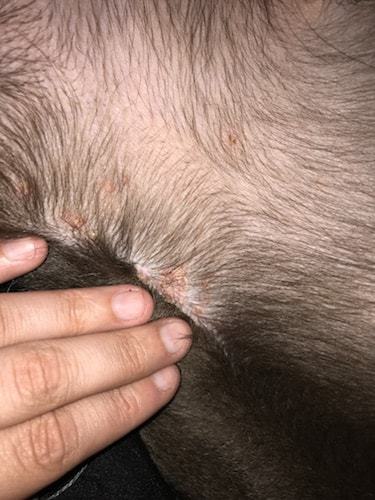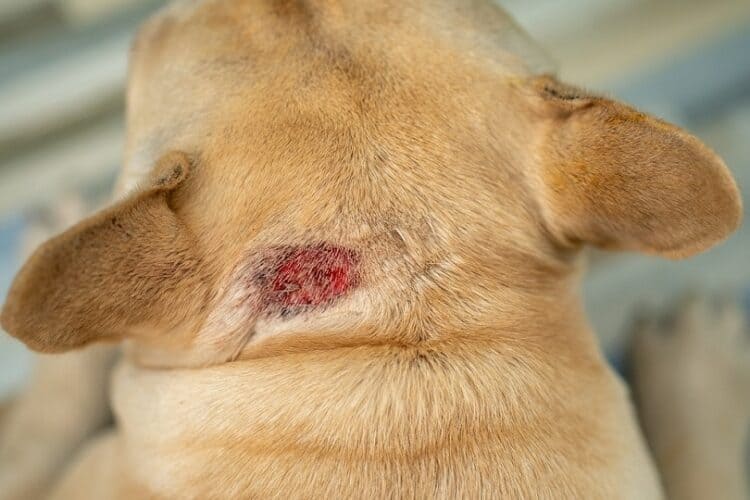Question: What are these scabs and bumps on my dog’s skin?
We have taken my dog to numerous vets to get more opinions but they all want to give us the same medication (Cephalexin) to “treat the problem.” It doesn’t treat anything. All it does is give him diarrhea and puke up his food. Onyx is a 1.5-year-old 80 lb silver lab. He has these scabs and bumps shown in the pictures all over his head, neck, and stomach. I don’t know if it’s a skin disease, infection, or if he is allergic to something. I bought Douxo Chlorhexidine PS Shampoo thinking it would help make the bumps go away but it doesn’t seem affected at all. We’ve been using it 2 times a week for 3 weeks now. Please help me figure out what’s wrong with my pup.
—Jordan

Answer:
Dear Jordan,
Thanks for the question about your dog’s skin. Seeing spots like that on your dog and not knowing why can be frustrating!
There are many disease processes that can cause lesions with a similar appearance. This makes it tough, if not impossible for your veterinarian to make a diagnosis just by looking at your pup’s skin. The following list includes three of the most common causes of skin bumps and scabs on dogs.
Allergies
The most common cause of allergy symptoms in dogs is pollen which causes symptoms when inhaled as well as when contacting the skin. We don’t know the reason why some dogs develop allergies. Allergic dermatitis can cause itchy skin, hair loss, redness, bumps, scabs, darkened skin, moist skin, and abnormal odors. Food allergies (much less common than pollen allergies) can cause similar skin lesions.
External parasites
Fleas are notorious dog pests. Some dogs are super sensitive to flea bites. Dogs with flea allergies can develop bumps, scabs, redness, itchiness, etc. Even if you don’t see a single flea on your dog, it is possible a few could be hiding on your dog, in your carpet, or yard. Good flea control is imperative when you have a dog with skin problems.
Our vets recommend either the Bayer Animal Health Seresto Flea and Tick Collar or the Rolf Club 3D Flea Collar as the best flea collars for dogs. For more picks, check out our full list of the Top Flea Collars.
Mites are another type of external parasite that can cause similar skin lesions. Demodex mites live in hair follicles and cause hair loss and redness but affected dogs aren’t usually very itchy. Demodex mites are not contagious to humans or other pets.
Scabies mites are less common but cause similar lesions with a lot of itchiness. Scabies mites are contagious to other pets and people.
Fungal Infection
In some parts of the country, fungal infections caused by organisms known as dermatophytes are common. You’ve probably heard the term “ringworm.” Ringworm is caused by a fungus, not a worm. Dermatophytosis (a.k.a. ringworm) causes hair loss, red skin, bumps, scaly skin, scabs, and sometimes itchiness. Ringworm is contagious to other animals and humans. Lime sulfur dips are an excellent way to treat topical ringworm. Learn more on How to Treat Ringworm in Dogs.
Diagnostic Testing of Dog’s Skin Bumps
Diagnosing the cause of bumps and scabs on the skin can be easy or very difficult depending on the cause. It’s best for vets to follow a protocol to make sure something isn’t missed.
- Physical Exam: The standard approach for making a diagnosis on a dog with skin lesions starts with an overall examination. Sometimes your vet can find evidence of fleas or other external parasites during the exam.
- Skin Scraping: Next, your vet will do a skin scraping with a microscopic examination to look for external parasites. Demodex mites are fairly easy to find with skin scraping. Scabies mites are more difficult to find with this test.
- Fungal Culture: If nothing is found with the skin scraping, the next step is to collect samples for a ringworm culture. Hair and/or skin samples are placed on fungal culture media for about 10 days to see if a dermatophyte fungus grows.
- Bacterial Culture: Although relatively uncommon, dogs can develop resistant bacterial skin infections that don’t respond to most antibiotics. A bacterial culture can identify the bacteria as well as make a recommendation for which antibiotic drug has the best chance to get rid of it.
- Cytology: A skin cytology can be helpful in diagnosing and treating skin disease. Your vet collects a sample with a clear piece of tape which she can examine under a microscope for bacteria and yeast. Skin infections are usually secondary to the underlying problem. Identifying the organisms will allow your vet to choose a medication to control secondary infections while the primary problem is being addressed.
- Allergy Testing: The gold standard for allergy testing involves injecting allergens into the skin to see which cause a reaction. Skin testing is done by veterinary dermatologists in most cases. There are options for blood testing for allergies, but the results may not be quite as accurate as skin testing. Many general practice vets offer blood testing and allergy treatment without a referral. Treatment with desensitization injections can help most dogs to some degree when managed well.
- Skin Biopsy: In some cases, your vet may need to do a skin biopsy to find out what’s causing bumps and scabs on your dog’s skin. After giving your dog a sedative and a local anesthetic, a small piece of the lesion is removed and sent to a pathologist for analysis. Skin biopsies are done when lesions are unusual or when all the other testing fails to make a diagnosis.
Diagnosis Leads to Better Treatment
Hopefully, you can see the challenges veterinarians face when it comes to diagnosing the cause of skin bumps and sores. Sometimes our first guess is correct but it’s not unusual to have a treatment failure or recurrence of lesions when no testing is done. Treating secondary skin infections with antibiotics will only make things better for a short time, as you’ve seen.
I suggest you ask your vet for a referral to a veterinary dermatologist if you’re interested in getting to the bottom of the problem. The short-term cost will pay off if your dog’s skin normalizes and you don’t have to keep returning to the vet so frequently.
Best Regards,
TB Thompson DVM
Featured Image Credit: Tienuskin, Shutterstock

















